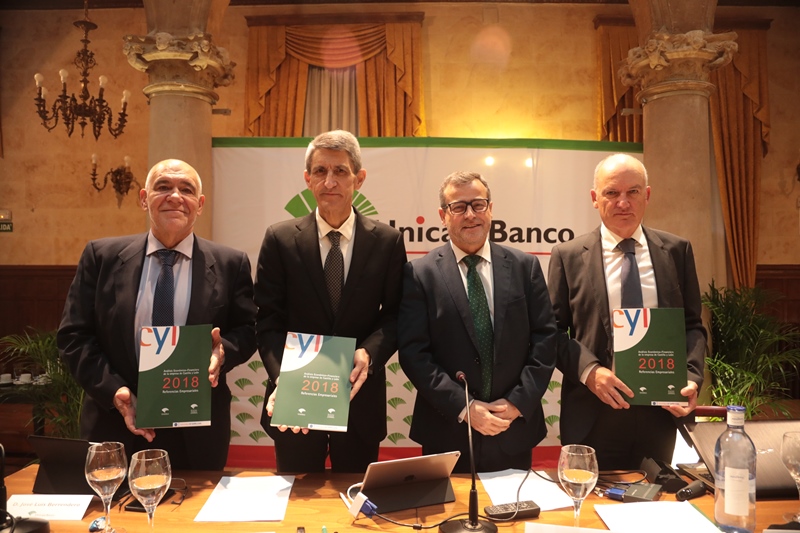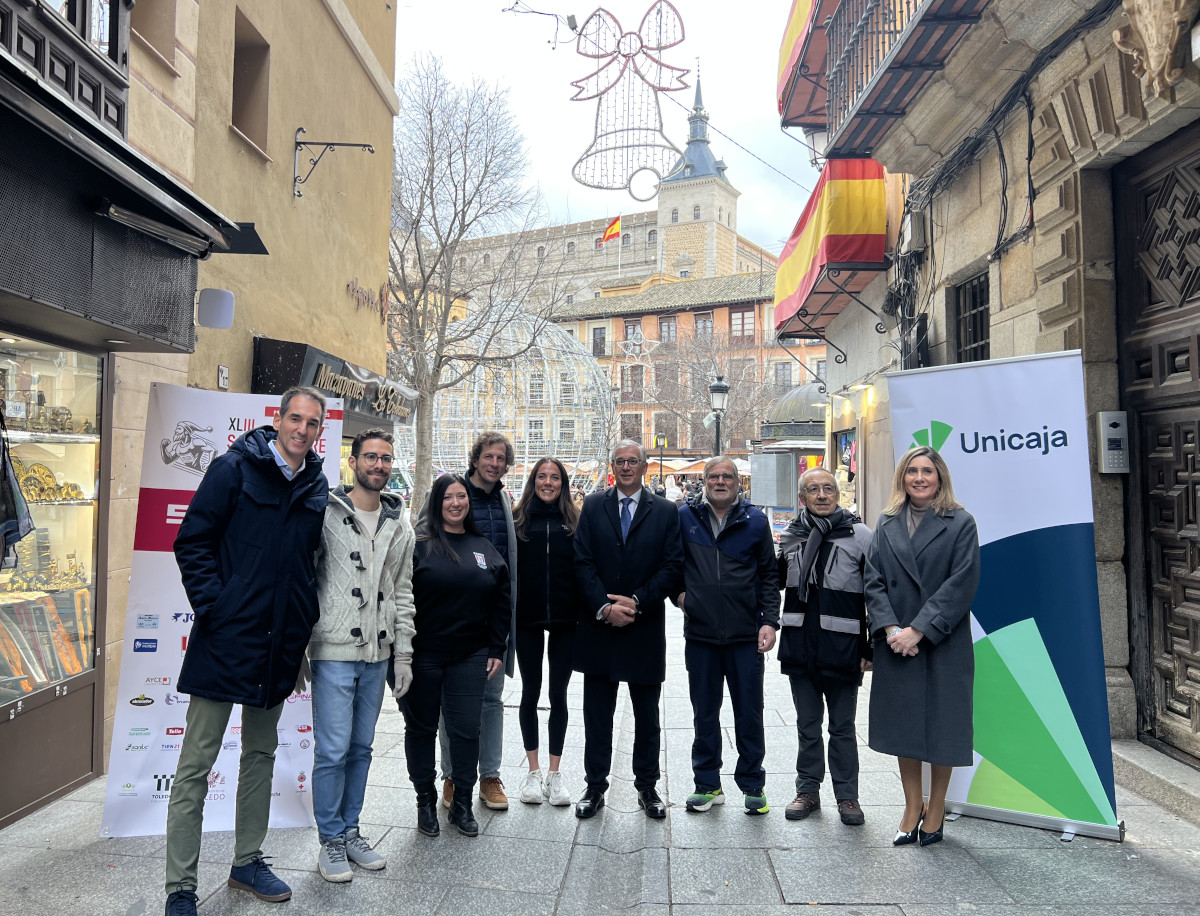The preparation and publication of this report falls within Unicaja Banco’s policy to support the business sector and to foster entrepreneurship, and is based on the analysis of the annual accounts presented by over 33,000 companies at the trade registers of Castilla y León, corresponding to the financial year 2016 –latest year with information available for all the companies which compose the sample.
This edition includes an advance of the results of Castilla y León companies in 2017.
Unicaja Banco has published the report ‘La Empresa de Castilla y León 2018.
Análisis Económico-Financiero’ (Companies in Castilla y León 2018. Economic and Financial Analysis), prepared by Analistas Económicos de Andalucía (Grupo Unicaja Banco’s research company). The document includes the business dynamic of the region and studies the behaviour of companies. It also identifies the ‘business references’, considering their capacity to generate resources, increase sales and obtain profitability.
The preparation and publication of this report falls within Unicaja Banco’s policy to support the business sector and to foster entrepreneurship, and is based on a detailed analysis of the annual accounts presented by over 33,000 companies at the trade registers of Castilla y León, corresponding to the financial year 2016 –latest year with information available for all the companies which compose the sample-. This edition includes an advance of the results of Castilla y León companies in 2017.
The report is structured as follows: after a first introductory section and the synthesis of the main results, a review is made of the economic context in which Castilla y León companies have carried out their activities. It focuses later on their demographic features (nature of the business activity, size and geographical location) and their evolution in recent years.
In a second block, the report analyses the companies which, because of their economic and financial behavior, are regarded as Business References, under three criteria: capacity to generate resources (leaders), capacity to increase sales (gazelles) and capacity to obtain a high profitability (high profitability). After this, attention is paid to the economic and financial evolution of regional companies during the period 2014-2016, although the core of the examined information is the last year. The economic and financial analysis ends with an advance of the results for the year 2017. Finally, a dictionary of economic and financial terms is included as an annex, to make it easier to understand and interpret the document, and to define the basic concepts used in the analysis.
The main results of the report are explained below:
Business demographic dynamics
In 2017, the Castilla y León economy continued the growth path started in the second semester of 2013, registering an increase of nearly 2.5% in production.
In this context, at the end of the year, 161,619 companies developed their activities in the Autonomous Community, a 0.2% year-on-year increase.
Regarding business density, Castilla y León there 66.7 companies per thousand inhabitants, 0.7% more than in the previous year.
With regard to their structure, by size, businesses without employees grew by 0.8%, those with 10 to 200 employees, by 2.0%; and those with more than 200, by 4.7%. Companies with 1 to 9 employees fell by 0.9%.
Considering the activity sector, non-commercial services gather 54.2% of the total of companies in the region; commercial services, 24%; construction, 14.6%, and industry, 7.2%. In comparison with the previous year, companies from the services and industrial sector registered increases (1.2% and 1.1% respectively).
The territorial analysis shows that Valladolid, with 33,967 companies (21.0% of the total of the region) and León, with 31,173 (19.3%), are the provinces with more companies. They are followed by Burgos (16.0%) and Salamanca (13.8%). Ávila, Burgos, Salamanca and Valladolid registered increases in the number of businesses in 2017.
The year 2017 saw the creation of 2,857 mercantile companies in Castilla y León. This figure represents 3.0% of the total national. In contrast, the number of dissolved companies reached 1,042 (4.8% of the total national), of which 7.6% were due to merger transactions.
Business References
With the data for the period 2013-2016, 1,980 companies in Castilla y León meet at least one of the three excellence criteria considered: 897 businesses are regarded as leaders (2.66% of the available sample), 568 as gazelles (2.12%) and 515 as high profitability (1.78%). The demanding conditions set are behind the fact that only 11 companies belong simultaneously to the three groups.
Considering size, medium-size enterprises have a higher relative weight in the category of leaders (43.7% of the total), exceeding the average distribution of the representative sample, while micro-enterprises excel in gazelles (69.0%) and high profitability (87.0%).
As per sector distribution, the preponderance of industrial companies in leaders (43.0% of the total) and gazelles (19.5%) is remarkable, as well as that of service companies in high profitability (55.7%).
From a territorial point of view, the province of Valladolid shows the largest concentration of business references in the region (28.5% of the total), with a share of 26.6% in leaders, 28.5% in gazelles and 31.8% in high profitability. Valladolid is followed by León, with 18.7% of the identified companies.
Finally, according to the population size, 46.6% out of the total of Business References are located in province capitals. By typologies, the highest relative weights are observed in province capitals stands for high profitability (53.4%), whereas leaders (57.1%) and gazelles (57.4%) are more represented in other cities and towns.
Economic and financial analysis and advance for 2017
In 2016, sales (business turnover) of Castilla y León companies increased by 8.2% (2.7% in the total national), with lower growth in 2017 (4.6% estimated). With regard to their size, large companies posted a growth higher than the regional total in 2016 (14.5%). From the point of view of sectors, the largest increase has been registered in industry (11.2%). By provinces, the growth of companies in Palencia (16.8%) and Valladolid (13.9%) stands over the regional average.
The year result in Castilla y León represents 2.9% of the business turnover, a 0.7 p.p. year-on-year increase, and the 2017 advance reaches 5.2%. Additionally, 66.3% of companies located in the region obtained positive results in 2016.
On the other hand, investment has increased by 3.3%, due to a growth of current investment (4.3%). Outlooks for 2017 suggest a growth of around 4.7%.
With regard to their financial structure, own funds increased by 4.7%, whereas in borrowed capital, the growth of short-term liabilities (5.7%) has been accompanied by a 1.4% decrease in non-current liabilities. As per their origin, liabilities with credit institutions represent 16% of indebtedness.
Regarding the performance of the business activity, an improvement has been noticed both in economic and financial profitability, reaching 4.5% and 5.6% respectively. The economic and financial profitability shows a growth trend in the advance of results for 2017 (5.5% and 10.8% respectively). In relation to economic profitability, the levels reached by large companies (5.1%) are to be remarked, as well as those of the industrial (5.9%) and agricultural (5.0%) sectors.
Unicaja Banco has published the report ‘La Empresa de Castilla y León 2018. Análisis Económico-Financiero’ (Companies in Castilla y León 2018. Economic and Financial Analysis), prepared by Analistas Económicos de Andalucía (Grupo Unicaja Banco’s research company). The document includes the business dynamic of the region and studies the behaviour of companies. It also identifies the ‘business references’, considering their capacity to generate resources, increase sales and obtain profitability.
The preparation and publication of this report falls within Unicaja Banco’s policy to support the business sector and to foster entrepreneurship, and is based on a detailed analysis of the annual accounts presented by over 33,000 companies at the trade registers of Castilla y León, corresponding to the financial year 2016 –latest year with information available for all the companies which compose the sample-. This edition includes an advance of the results of Castilla y León companies in 2017
The report is structured as follows: after a first introductory section and the synthesis of the main results, a review is made of the economic context in which Castilla y León companies have carried out their activities. It focuses later on their demographic features (nature of the business activity, size and geographical location) and their evolution in recent years.
In a second block, the report analyses the companies which, because of their economic and financial behavior, are regarded as Business References, under three criteria: capacity to generate resources (leaders), capacity to increase sales (gazelles) and capacity to obtain a high profitability (high profitability). After this, attention is paid to the economic and financial evolution of regional companies during the period 2014-2016, although the core of the examined information is the last year. The economic and financial analysis ends with an advance of the results for the year 2017. Finally, a dictionary of economic and financial terms is included as an annex, to make it easier to understand and interpret the document, and to define the basic concepts used in the analysis.
The main results of the report are explained below:
Business demographic dynamics
In 2017, the Castilla y León economy continued the growth path started in the second semester of 2013, registering an increase of nearly 2.5% in production.
In this context, at the end of the year, 161,619 companies developed their activities in the Autonomous Community, a 0.2% year-on-year increase.
Regarding business density, Castilla y León there 66.7 companies per thousand inhabitants, 0.7% more than in the previous year.
With regard to their structure, by size, businesses without employees grew by 0.8%, those with 10 to 200 employees, by 2.0%; and those with more than 200, by 4.7%. Companies with 1 to 9 employees fell by 0.9%.
Considering the activity sector, non-commercial services gather 54.2% of the total of companies in the region; commercial services, 24%; construction, 14.6%, and industry, 7.2%. In comparison with the previous year, companies from the services and industrial sector registered increases (1.2% and 1.1% respectively).
The territorial analysis shows that Valladolid, with 33,967 companies (21.0% of the total of the region) and León, with 31,173 (19.3%), are the provinces with more companies. They are followed by Burgos (16.0%) and Salamanca (13.8%). Ávila, Burgos, Salamanca and Valladolid registered increases in the number of businesses in 2017.
The year 2017 saw the creation of 2,857 mercantile companies in Castilla y León. This figure represents 3.0% of the total national. In contrast, the number of dissolved companies reached 1,042 (4.8% of the total national), of which 7.6% were due to merger transactions.
Business References
With the data for the period 2013-2016, 1,980 companies in Castilla y León meet at least one of the three excellence criteria considered: 897 businesses are regarded as leaders (2.66% of the available sample), 568 as gazelles (2.12%) and 515 as high profitability (1.78%). The demanding conditions set are behind the fact that only 11 companies belong simultaneously to the three groups.
Considering size, medium-size enterprises have a higher relative weight in the category of leaders (43.7% of the total), exceeding the average distribution of the representative sample, while micro-enterprises excel in gazelles (69.0%) and high profitability (87.0%).
As per sector distribution, the preponderance of industrial companies in leaders (43.0% of the total) and gazelles (19.5%) is remarkable, as well as that of service companies in high profitability (55.7%).
From a territorial point of view, the province of Valladolid shows the largest concentration of business references in the region (28.5% of the total), with a share of 26.6% in leaders, 28.5% in gazelles and 31.8% in high profitability. Valladolid is followed by León, with 18.7% of the identified companies.
Finally, according to the population size, 46.6% out of the total of Business References are located in province capitals. By typologies, the highest relative weights are observed in province capitals stands for high profitability (53.4%), whereas leaders (57.1%) and gazelles (57.4%) are more represented in other cities and towns.
Economic and financial analysis and advance for 2017
In 2016, sales (business turnover) of Castilla y León companies increased by 8.2% (2.7% in the total national), with lower growth in 2017 (4.6% estimated). With regard to their size, large companies posted a growth higher than the regional total in 2016 (14.5%). From the point of view of sectors, the largest increase has been registered in industry (11.2%). By provinces, the growth of companies in Palencia (16.8%) and Valladolid (13.9%) stands over the regional average.
The year result in Castilla y León represents 2.9% of the business turnover, a 0.7 p.p. year-on-year increase, and the 2017 advance reaches 5.2%. Additionally, 66.3% of companies located in the region obtained positive results in 2016.
On the other hand, investment has increased by 3.3%, due to a growth of current investment (4.3%). Outlooks for 2017 suggest a growth of around 4.7%.
With regard to their financial structure, own funds increased by 4.7%, whereas in borrowed capital, the growth of short-term liabilities (5.7%) has been accompanied by a 1.4% decrease in non-current liabilities. As per their origin, liabilities with credit institutions represent 16% of indebtedness.
Regarding the performance of the business activity, an improvement has been noticed both in economic and financial profitability, reaching 4.5% and 5.6% respectively. The economic and financial profitability shows a growth trend in the advance of results for 2017 (5.5% and 10.8% respectively). In relation to economic profitability, the levels reached by large companies (5.1%) are to be remarked, as well as those of the industrial (5.9%) and agricultural (5.0%) sectors.
Download Análisis Económico-Financiero de la empresa de Castilla y León



